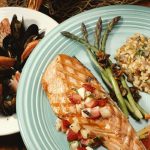
Eating protein every day is important for good health. While it can come from animal and/or plant sources, the amount of protein we need is rather small — just 5 to 7 “ounce equivalents,” according to the U.S. Department of Agriculture. An ounce equivalent can be one ounce of meat, poultry or seafood; one large egg; a quarter-cup of cooked legumes like beans or lentils; a half ounce of nuts or seeds; or one tablespoon of nut butter. In terms of volume, 5 to 7 ounces isn’t much and could leave you feeling unsatisfied. So, when you’re restricting calories, it’s important to maximize your protein choices. For instance, as tasty as peanut butter is, one tablespoon is barely more than one good-sized bite. For the same 100 calories, you can have a large egg plus two large egg whites — that’s a lot of filling protein. Ounce for ounce, lean fish fillets, like cod and flounder, and shellfish, like shrimp, have about half the calories of even lean cuts of beef and one-third fewer than skinless chicken. And don’t overlook thick and rich Greek yogurt. A full cup of the fat-free plain variety has about 130 calories, 17 grams of protein and a boost of calcium. When dieting, you may want to trade some fat calories for protein, again because of the added volume. In… read on >

















